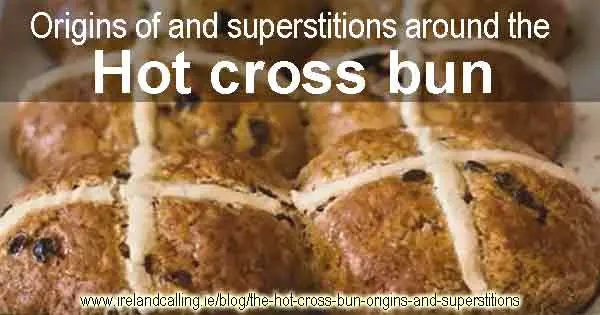The hot cross bun has been associated with Good Friday for centuries – for many people the cross is a religious symbol to remind Christians of Jesus’ death.
This is certainly what the cross means to millions across the world today, but there are actually many myths and legends about the buns. The origins are shrouded in mystery and so very difficult to say for sure what, if anything, the cross originally symbolised.
It is likely that what we now know as hot cross buns pre-dated Christianity and was used by several other cultures throughout history.

Origins in pagan societies
Sue Ellen Thompson, author of Holiday Symbols and Customs wrote: “The pagans worshipped the goddess Ēostre (after whom Easter was named) by serving tiny cakes, often decorated with a cross, at their annual spring festival. When archaeologists excavated the ancient city of Herculaneum in south-western Italy, which had been buried under volcanic ash and lava since 79 C.E., they found two small loaves, each with a cross on it, among the ruins.”
Rowan Strong is the Associate Professor of Church History at Murdoch University.
He said: “Some speculate [hot cross buns] may have had their origins in pagan customs which Christians took over. But they are certainly well-attested in the medieval period, where they were associated with Easter, and were particularly eaten on Good Friday, because of the association with the crucifixion.”
Alan Davidson, author of ‘Oxford Companion to Food’ said: “The Saxons ate buns marked with a cross in honour of the goddess of light, Ēostre, whose name was transferred to Easter.”
Ancient Greeks and Romans had versions of hot cross buns
In ‘An A to Z of Food & Drink’ John Ayto wrote: “The practice of eating special small cakes at the time of the Spring festival seems to date back at least to the ancient Greeks, but the English custom of eating spiced buns on Good Friday was perhaps institutionalized in Tudor times, when a London bylaw was introduced forbidding the sale of such buns except on Good Friday, at Christmas, and at burials.”
Revd Dr Andrew McGowan of the University of Melbourne said: “There were breads marked with cross-shapes in the ancient world, allowing diners to easily divide loaves into four pieces.”
Christians adopted the ‘cross bun’ tradition
Rowan Strong said: “Cross buns were definitely a part of the customs by which Christian beliefs entered into the homes and domestic cultures of Christians through the Middle Ages, so that Christianity was not just something that happened in church, but was part of a living Christian culture, associated with the round of the Christian year and the sacred seasons.
“There are other examples of this too – fish on Fridays, pancakes on Shrove Tuesday. But these customs underwent a massive reduction in the Reformation, as they were labelled superstitious by the reformers.
“Some have survived, like hot cross buns, only to be shorn of their Christian meaning with the growth of secular culture.”
Revd McGowen said that the cross: “Was certainly a specific addition to remind eaters of the cross of Jesus.”
Queen Elizabeth I restricted production of cross buns
Strong also said: “Protestant reformers in England disliked the practice [of eating cross buns]. For them, it was associated with Catholic superstition.”
Protestant Queen Elizabeth I even went so far as to legislate that hot cross buns could only be eaten at Christmas and Easter. Often religious festivals brought out the best in people and the buns were given to the needy on Good Friday.
When were they first known as ‘cross buns’?
The term ‘cross bun’ wasn’t recorded until the 1700s. Revd McGowan said: “It was certainly a specific addition to remind eaters of the cross of Jesus.”
A passage from ‘Poor Robin’s Almanac’ from 1733 read: “Good Friday comes this month, the old woman runs, with one or two a penny hot cross buns”. It is thought to be the first reference to ‘cross bun’.
Superstition
One superstition states that hot cross buns baked on Good Friday will stay fresh all year. Alan Davidson said: “According to superstition, hot cross buns and loaves baked on Good Friday never went mouldy, and were sometimes kept as charms from one year to the next.”
The buns were also thought to protect people from harm that may come their way such as evil spirits and physical harm. It was even thought to have healing qualities.
Sue Ellen Thompson said: “Superstitions regarding bread that was baked on Good Friday date back to a very early period. In England particularly, people believed that bread baked on this day could be hardened in the oven and kept all year to protect the house from fire. Sailors took leaves of it on their voyages to prevent shipwreck, and a Good Friday loaf was often buried in a heap of corn to protect it from rats, mice, and weevils. Finely grated and mixed with water, it was sometimes used as a medicine.
If you’re the superstitious type, why not make your own hot cross buns? Videos and recipes here
Irish Symbols – each with their own fascinating origins and still relevant today
Celtic Cross
Brigid’s Cross
How Ireland protects its harp and shamrock emblems…take care if using them
Why the Guinness harp faces the opposite way to the official Irish harp
Celtic Jewelry/jewellery